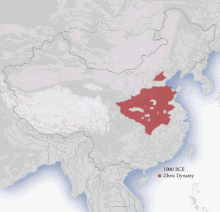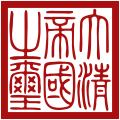Monarchy of China

| Part of a series on the |
| History of China |
|---|
China was a monarchy from prehistoric times up to 1912 CE, when the Xinhai Revolution overthrew the Qing dynasty in favor of the Republic of China. The succession of mythological monarchs of China were non-hereditary. Dynastic rule began in circa 2070 BCE when Yu the Great established the Xia dynasty, and lasted until 1912 CE when dynastic rule collapsed together with the monarchical system.[1]
The monarchy of China took the form of absolute monarchy, even though the actual power of the ruler was dependent upon his/her ability to consolidate the rule. During periods of political disunity, China was under the rule of competing dynasties, each ruling a part of China and claiming exclusive Chinese politico-cultural orthodoxy; in such cases, more than one Chinese monarchy existed simultaneously. Throughout history, there were monarchs of both ethnic Han and non-Han origins.[2]
Domains of the Chinese monarchy
While the Chinese monarchy was originally established along the Yellow River and Yangtze River in China proper, various Chinese dynasties expanded beyond the region to encompass other domains.[3][4][5][6][7][8][9][10][11][12][13][14][15]
At various points in time, the Chinese monarchy exercised control over China proper (including Hainan, Macau, and Hong Kong),[3][4][5] Taiwan,[6] Manchuria (both Inner Manchuria and Outer Manchuria),[7][8] Sakhalin,[9][10] Mongolia (both Inner Mongolia and Outer Mongolia),[8][11] Vietnam,[8][12] Tibet,[7] Xinjiang,[13] as well as parts of Central Asia,[9] the Korean Peninsula,[8][14] Afghanistan,[15][16] and Siberia.[8]
Apart from exerting direct control over the Chinese realm, the Chinese monarchy also maintained hegemony through the Chinese tributary system.[17]
Monarchism in China
After the success of the Xinhai Revolution, there were various attempts at re-establishing the Chinese monarchy.
Empire of China
In 1915 CE, Yuan Shikai proclaimed the Empire of China.[18] It soon sparked the National Protection War and the empire was abolished after three months.
Manchu Restoration
In 1917 CE, the Qing loyalist Zhang Xun reinstalled Puyi to the Chinese throne.[19] This attempt at restoring the Qing dynasty, known as the Manchu Restoration, lasted only 12 days.
Manchukuo
The Japanese puppet state Manchukuo was established in Northeast China in 1932 CE.[20] This regime subsequently became a monarchy with Puyi as the emperor in 1934 CE. Manchukuo collapsed in 1945 CE following the Soviet invasion of Manchuria and the unconditional surrender of Japan.
Gallery
-
The Portraits of Periodical Offering of Liang illustrates foreign envoys in China during the Liang dynasty.
-
The reconstructed Danfeng Gate of the Daming Palace, the imperial palace complex of the Tang dynasty.
-
A painting by Liu Guandao depicting the Emperor Shizu of Yuan on a hunting expedition.
-
A Bengali envoy presenting a giraffe as a tributary gift in the name of Sultan Saifuddin Hamza Shah of Bengal to the Yongle Emperor.
-
The Dragon Throne in the Palace of Heavenly Purity within the Forbidden City was a symbol of Chinese imperial power. The "Dragon Throne" can also be used metonymically to refer to the monarchy of China.
-
The imperial seal of the Qing dynasty.
See also
- Chinese Empire Reform Association
- Chinese imperialism
- Chinese nobility
- Chinese sovereign
- Dragon Throne
- Dynasties in Chinese history
- East Asian cultural sphere
- Emperor at home, king abroad
- Emperor of China
- Family tree of ancient Chinese emperors
- Family tree of Chinese monarchs (early)
- Family tree of Chinese monarchs (late)
- Family tree of Chinese monarchs (middle)
- Foreign relations of imperial China
- Golden ages of China
- Head of the former Chinese imperial clan
- Head of the House of Aisin Gioro
- Historical capitals of China
- History of China
- List of Chinese monarchs
- List of recipients of tribute from China
- List of tributary states of China
- Mandate of Heaven
- Names of China
- Pax Sinica
- Political systems of Imperial China
- Royalist Party
- Sinicization
- Sinocentrism
- Timeline of Chinese history
- Tongmenghui
- Tributary system of China
References
- ^ Ebrey, Patricia; Liu, Kwang-Ching (2010). The Cambridge Illustrated History of China. p. 10. ISBN 9780521124331.
- ^ Skutsch, Carl (2013). Encyclopedia of the World's Minorities. p. 287. ISBN 9781135193881.
- ^ a b Brødsgaard, Kjeld (2008). Hainan – State, Society, and Business in a Chinese Province. p. 11. ISBN 9781134045471.
- ^ a b Wong, Koon-kwai (2009). Hong Kong, Macau and the Pearl River Delta: A Geographical Survey. pp. 241–242. ISBN 9789882004757.
- ^ a b Zhang, Wei Bin (2006). Hong Kong: The Pearl Made of British Mastery and Chinese Docile-diligence. p. 3. ISBN 9781594546006.
- ^ a b Hughes, Christopher (2013). Taiwan and Chinese Nationalism: National Identity and Status in International Society. p. 21. ISBN 9781134727551.
- ^ a b c Hsu, Cho-yun (2012). China: A New Cultural History. p. 421. ISBN 9780231528184.
- ^ a b c d e f Lockard, Craig (2020). Societies, Networks, and Transitions: A Global History. p. 260. ISBN 9780357365472.
- ^ a b c Gan, Chunsong (2019). A Concise Reader of Chinese Culture. p. 24. ISBN 9789811388675.
- ^ a b Westad, Odd (2012). Restless Empire: China and the World Since 1750. Basic Books. p. 11.
qing dynasty sakhalin.
- ^ a b Sanders, Alan (2003). Historical Dictionary of Mongolia. p. v. ISBN 9780810866010.
- ^ a b Paige, Jeffrey (1978). Agrarian Revolution. p. 278. ISBN 9780029235508.
- ^ a b Clarke, Michael (2011). Xinjiang and China's Rise in Central Asia - A History. p. 16. ISBN 9781136827068.
- ^ a b Kshetry, Gopal (2008). Foreigners in Japan: A Historical Perspective. p. 25. ISBN 9781469102443.
- ^ a b Tanner, Harold (2009). China: A History. p. 167. ISBN 9780872209152.
- ^ Hsu (2012). p. 268.
- ^ Kavalski, Emilian (2014). Asian Thought on China's Changing International Relations. pp. 56–57. ISBN 9781137299338.
- ^ Schillinger, Nicholas (2016). The Body and Military Masculinity in Late Qing and Early Republican China: The Art of Governing Soldiers. p. 176. ISBN 9781498531696.
- ^ Hao, Shiyuan (2019). China's Solution to Its Ethno-national Issues. p. 51. ISBN 9789813295193.
- ^ Wells, Anne (2009). The A to Z of World War II: The War Against Japan. p. 167. ISBN 9780810870260.




